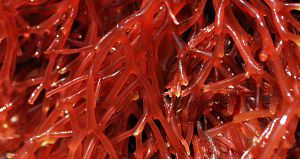 Red Seaweed (Kappaphycus), is a genus of red algae. Farming of this seaweed started in southern Mindanao in the mid ’60s, and has expanded to other parts of the Philippines and to other countries like Indonesia, Fiji, Micronesia, Vietnam, China, and South Africa.
Red Seaweed (Kappaphycus), is a genus of red algae. Farming of this seaweed started in southern Mindanao in the mid ’60s, and has expanded to other parts of the Philippines and to other countries like Indonesia, Fiji, Micronesia, Vietnam, China, and South Africa.
Genus Kappaphycus is “morphologically plastic”, with few visible characters that can be used to separate the taxa, so distinguishing the species can be difficult. In addition, many commercial varieties have been bred. Molecular analyses can be used.
In general, these algae have fleshy thalli that grow erect from one or more anchors. The longest individuals can exceed a meter in length. All species produce kappa-carrageenan. Farming of this is a large business in the Philippines. Prof. Gavino Cajulao Trono Jr is a Filipino biologist dubbed the “Father of Kappaphycus farming”.
Red seaweed commonly called ‘guzo’ or ‘tambalang.’ There are three common strains which are appropriate for farming. These are brown, green and red strains. Kappaphycus is naturally found below 0 tide line on sandy-rocky to corally substrate in the tropical intertidal and sub-tidal waters.
Farming of Red Seaweed (Kappaphycus):
For more details, contact:
SEAFDEC Aquaculture Department
Room 102, Ground Floor, Philippine Social Science Center
Commonwealth Ave. corner Central Ave.
1101 Diliman, Quezon City
Tel: (02) 455-0981, 927-5542
Telefax: (02) 927-7825
E-mail: [email protected]
SEAFDEC Aquaculture Department
Tigbauan 5021, Iloilo
Trunkline connecting all offices:
(033) 315-5665
(033) 511-9170 to 71
Email: [email protected]
Source: SEAFDEC, en.wikipedia.org; Photo: sarahluck.wordpress.com